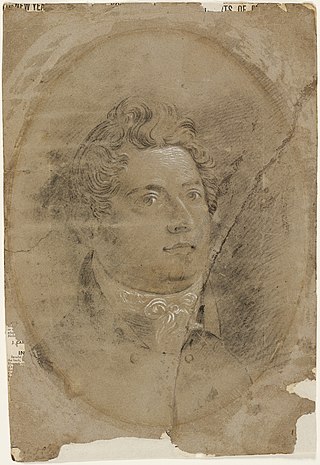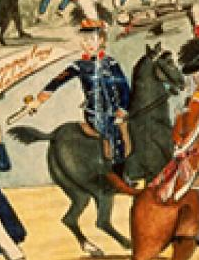| |||||
| Decades: | |||||
|---|---|---|---|---|---|
| See also: | |||||
The following lists events that happened during 1821 in Australia.
| |||||
| Decades: | |||||
|---|---|---|---|---|---|
| See also: | |||||
The following lists events that happened during 1821 in Australia.
Governors of the Australian colonies:

Major General Sir Thomas Makdougall Brisbane, 1st Baronet,, was a British Army officer, administrator, and astronomer. Upon the recommendation of the Duke of Wellington, with whom he had served, he was appointed governor of New South Wales from 1821 to 1825.

Major General Lachlan Macquarie, CB was a British Army officer and colonial administrator from Scotland. Macquarie served as the fifth Governor of New South Wales from 1810 to 1821, and had a leading role in the social, economic, and architectural development of the colony. He is considered by historians to have had a crucial influence on the transition of New South Wales from a penal colony to a free settlement and therefore to have played a major role in the shaping of Australian society in the early nineteenth century.

Francis Howard Greenway was an English-born architect who was transported to Australia as a convict for the crime of forgery. In New South Wales he worked for the Governor, Lachlan Macquarie, as Australia's first government architect. He became widely known and admired for his work displayed in buildings such as St Matthew's Church, St James' Church and Hyde Park Barracks.
D'Arcy Wentworth was an Irish surgeon, the first paying passenger to arrive in the new colony of New South Wales. He served under the first seven governors of the Colony, and from 1810 to 1821, he was great assistant to Governor Lachlan Macquarie. Wentworth led a campaign for the rights and recognition of emancipists and for trial by jury.
Edward Eagar (1787–1866) was a lawyer, merchant and criminal.
The history of Australia from 1788 to 1850 covers the early British colonial period of Australia's history. This started with the arrival in 1788 of the First Fleet of British ships at Port Jackson on the lands of the Eora, and the establishment of the penal colony of New South Wales as part of the British Empire. It further covers the European scientific exploration of the continent and the establishment of the other Australian colonies that make up the modern states of Australia.

John Thomas Bigge was an English judge and royal commissioner. He is mostly known for his inquiry into the British colony of New South Wales published in the early 1820s. His reports favoured a return to the harsh treatment of convicts and the utilisation of them as cheap agricultural labour for wealthy sheep-farming colonists. Bigge's reports also resulted in the resignation of Governor Lachlan Macquarie whose policies promoted the advancement of ex-convicts back into society.
James Meehan was an Irish Australian explorer and surveyor.

John Therry was an Irish Roman Catholic priest in Sydney, Australia.

The Parramatta Female Factory, is a National Heritage Listed place and has three original sandstone buildings and the sandstone gaol walls. The Parramatta Female Factory was designed by convict architect Francis Greenway in 1818 and the only female building authorized by Governor Lachlan Macquarie. It comprises the 1821 Matron's Quarters and Administration and Stores Building, the 1821 Female Hospital and the 1826 3rd Class Female Penitentiary. It is the first female factory in the penal colony of New South Wales, and is located at 5 Fleet Street, North Parramatta, New South Wales, Australia. It was one of 13 female factories in the colonies of New South Wales and Van Diemen's Land. In New South Wales, female factories were also established in Bathurst, Newcastle, Port Macquarie and Moreton Bay. The factory idea was a combination of the functions of the British bridewells, prisons and workhouses. The Parramatta Female Factory is being considered for World Heritage listing.
The following lists events that happened during 1822 in Australia.

The Old Government House is a heritage-listed former "country" residence used by ten early governors of New South Wales between 1800 and 1847, located in Parramatta Park in Parramatta, New South Wales, in the greater metropolitan area of Western Sydney, New South Wales, Australia. It is considered a property of national and international significance as an archaeological resource. It also serves to demonstrate how the British Empire expanded and Australian society has evolved since 1788.

St John's Cathedral is a heritage-listed, Anglican cathedral in Parramatta, City of Parramatta, Sydney, New South Wales, Australia. St John's was given the status of provisional cathedral of the Anglican Diocese of Sydney in 1969, and designated a Regional Cathedral in 2011 for the Western Region. It was added to the New South Wales State Heritage Register on 5 March 2010.
John Thomas Campbell (1770–1830) was a public servant and politician in the New South Wales Legislative Council during the early Australian colonial period.

Thomas Hassall was an Anglican clergyman and the first Australian candidate for ordination. Hassall opened the first Sunday School in Australia in 1813 in his father's house at Parramatta.

The Blacktown Native Institution Site is the heritage-listed site of a former residential school for Aboriginal and Māori children at Richmond Road, Oakhurst, City of Blacktown, New South Wales, Australia. It was built from 1822. The site has also been known as Parramatta Native Institute, Black Town Institute, The Blacktown Site, Lloydhurst, BNI, Epping Estate, Epping Forest Estate and Native Institution Centre. The property is owned by Blacktown City Council, Department of Planning and Infrastructure and Landcom. It was added to the New South Wales State Heritage Register on 18 November 2011.

St Thomas' Anglican Church is a heritage-listed Anglican church at Hay Street, Port Macquarie, Port Macquarie-Hastings Council, New South Wales, Australia. It was built from 1823 to 1827 by convict labour under military supervision. The property is owned by the Anglican Diocese of Grafton. It was added to the New South Wales State Heritage Register on 18 October 2002.

The Governor's Body Guard of Light Horse was a military unit maintained in the Colony of New South Wales between 1801 and 1834, and reputedly the "first full-time military unit raised in Australia". It was established by Governor Philip Gidley King by drawing men from the New South Wales Corps, the British garrison in the colony. Normally consisting of one or two non-commissioned officers and six privates, the Guard provided an escort to the governor and carried his despatches to outposts across the colony. From 1802, the men of the Guard were drawn from convicts pardoned by King. Men from the unit were deployed during the Castle Hill convict rebellion of 1804 and a trooper of the Guard assisted in the capture of two of the rebel leaders.
Parramatta Archaeological Site is a heritage-listed urban facility at 45 Macquarie Street, Parramatta, City of Parramatta, New South Wales, Australia. It is also known as Archaeological Site and Associated Artefacts and V by Crown; 45 Macquarie Street; Wheatsheaf Hotel & Convict Hut Archaeological Site; Foundry/Blacksmithy; Industrial Archaeological Site. The property is privately owned. The site was added to the New South Wales State Heritage Register on 5 July 2019.
Catherine Fitzpatrick (1785–1861), née Milling, was the founder and first conductor of St. Mary's Cathedral Choir, in Sydney, Australia.